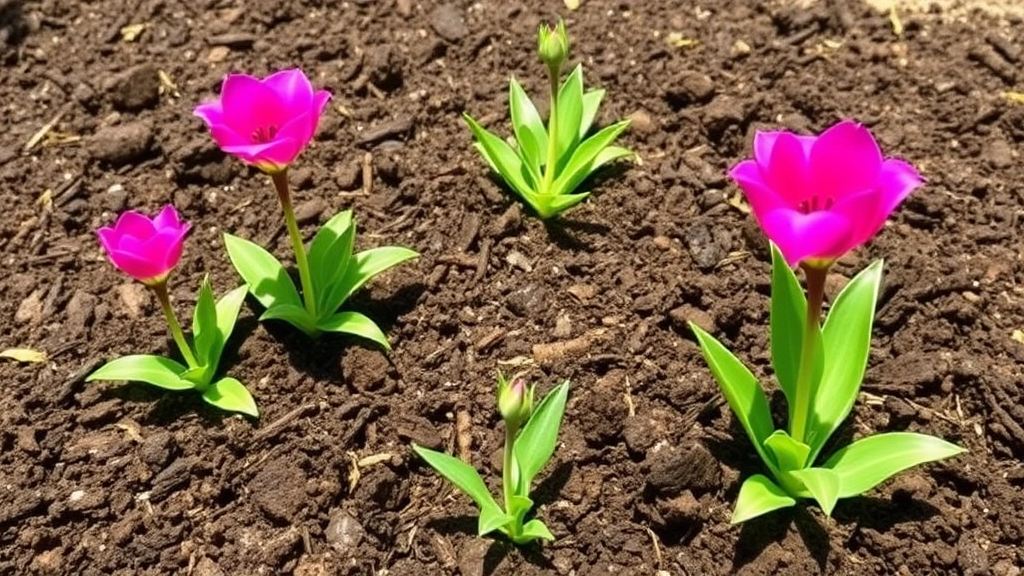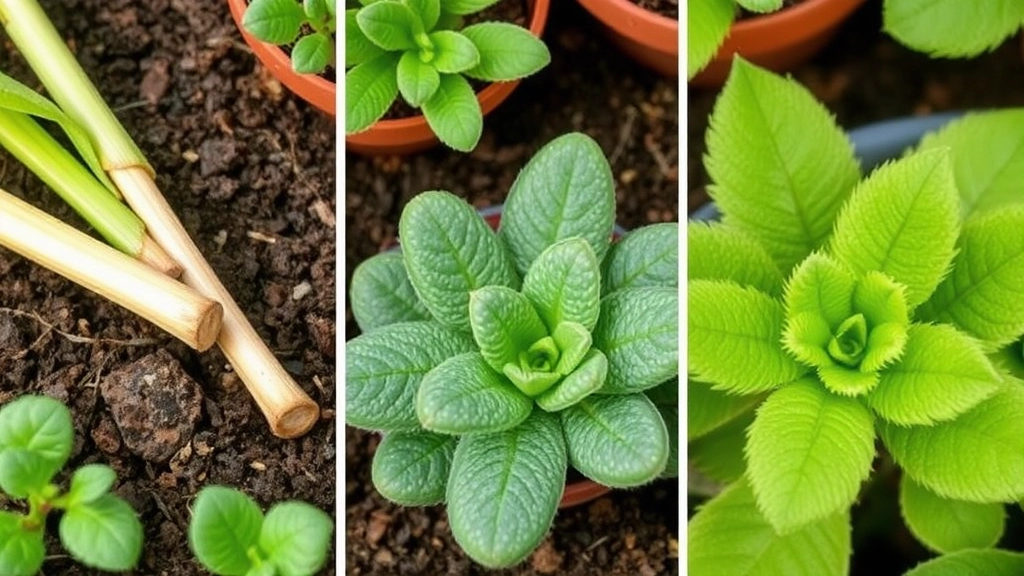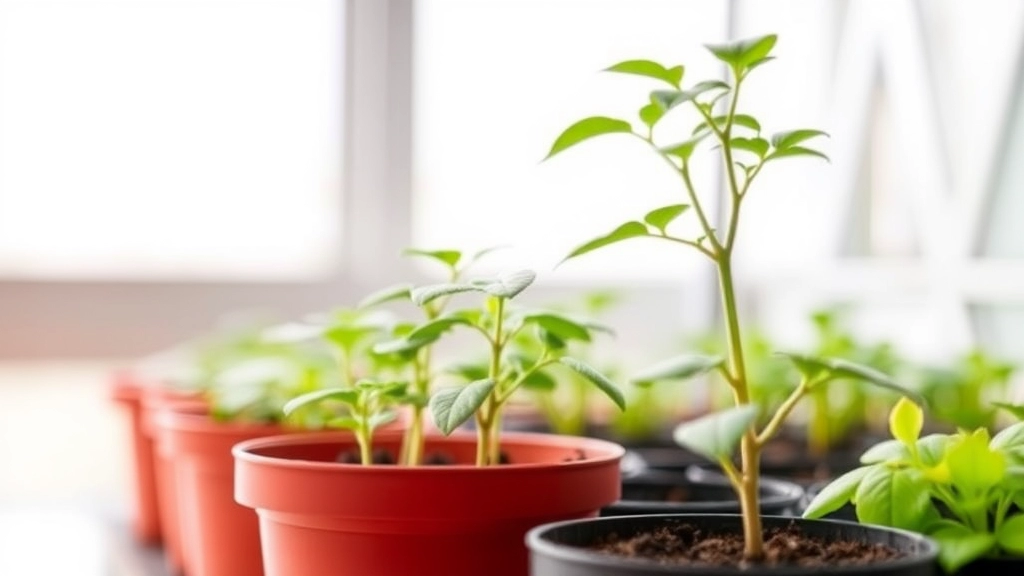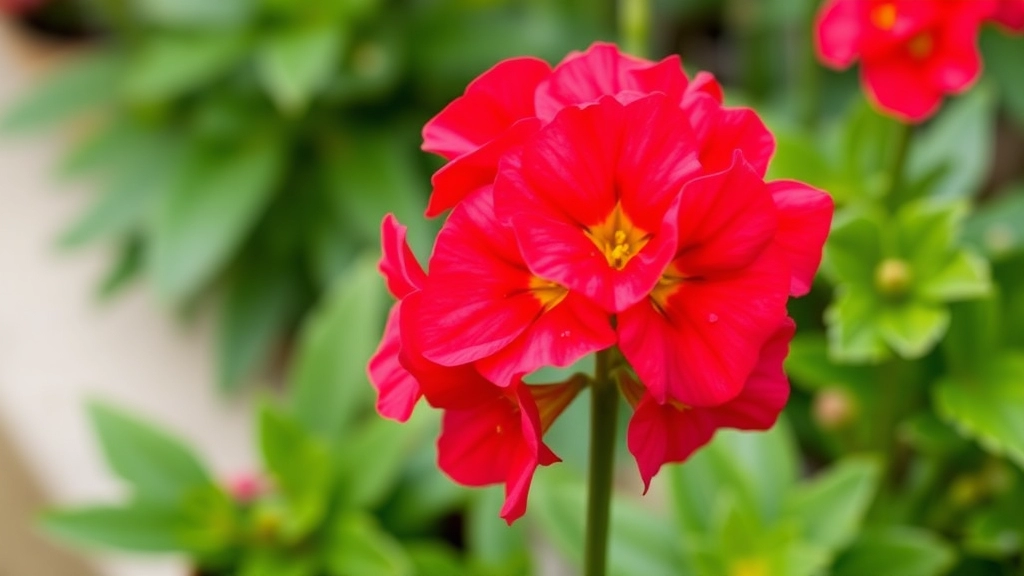Flaming Katy Kalanchoe Blossfeldiana
Flaming Katy Kalanchoe Blossfeldiana is a vibrant, easy-to-care-for succulent that brightens up any indoor space. If you’re looking to grow this stunning plant, you’ll need to understand its ideal growing conditions. From light and water requirements to proper soil maintenance, getting these basics right is crucial for a healthy, blooming Flaming Katy.
Maintenance Tips
Maintaining your Flaming Katy involves more than just watering. Pruning techniques can encourage new growth and more blooms, while proper propagation methods ensure you can share this beauty with friends. Keep an eye out for common pests and diseases, and follow seasonal care tips to keep your Kalanchoe Blossfeldiana thriving year-round.
Ideal Growing Conditions for Flaming Katy
Are you struggling to keep your Flaming Katy (Kalanchoe blossfeldiana) thriving?
Understanding the ideal growing conditions is crucial for ensuring your plant flourishes.
Light Requirements
Flaming Katy loves bright, indirect sunlight.
- Optimal Light: Aim for 6 hours of light daily.
- Avoid Direct Sun: Too much direct sunlight can scorch the leaves.
Temperature Preferences
This succulent prefers a warm environment.
- Ideal Temperature: 20-25°C (68-77°F) during the day.
- Nighttime Temperature: A slight drop to around 15°C (59°F) is acceptable.
Humidity Levels
Flaming Katy thrives in low to moderate humidity.
- Humidity Range: 40-60% is ideal.
- Avoid High Humidity: Excess moisture can lead to root rot.
Soil Type
The right soil mix is essential for healthy growth.
- Well-Draining Soil: Use a cactus or succulent mix.
- pH Level: Aim for a slightly acidic to neutral pH (6.0-7.0).
Potting Considerations
Choosing the right pot can make a difference.
- Drainage Holes: Ensure your pot has drainage holes to prevent water accumulation.
- Size: Select a pot that allows for some growth without being overly large.
For more detailed information on caring for your Flaming Katy, check out our Complete Care Guide for Kalanchoe Blossfeldiana. Additionally, if you’re facing specific issues with your plant’s leaves, our Leaf Care Tips and Troubleshooting article can be very helpful.
How to Water and Maintain Soil for Flaming Katy

So, you’ve got your Flaming Katy (Kalanchoe blossfeldiana) and you’re wondering how to keep it thriving.
Watering: The Right Balance
One of the biggest worries for plant parents is overwatering.
- Water only when the soil is dry to the touch.
- Stick your finger about an inch into the soil; if it feels dry, it’s time for a drink.
- When you do water, give it a good soak until you see water draining from the bottom.
Remember, Flaming Katy prefers to be on the drier side rather than soggy.
Soil: The Foundation of Health
Now, let’s talk soil.
- Well-draining soil is a must. A cactus or succulent mix works wonders.
- You can also mix regular potting soil with sand or perlite to enhance drainage.
- Aim for a slightly acidic to neutral pH (around 6.0 to 7.0).
A good pot with drainage holes is essential too. This helps prevent root rot, which can be a real killer for your plant.
Fertilising: Give It a Boost
During the growing season (spring and summer), your Flaming Katy might appreciate a little extra love.
- Use a balanced, water-soluble fertilizer every 4-6 weeks.
- Dilute it to half strength to avoid burning the roots.
This will encourage lush growth and vibrant blooms.
Signs of Trouble
Keep an eye out for signs that your plant isn’t happy.
- Yellowing leaves? That could mean it’s getting too much water.
- Brown leaf tips? It might be thirsty or need more humidity.
By keeping an eye on these signs, you can adjust your care routine accordingly.
Pruning Techniques to Encourage Growth and Blooms
When it comes to nurturing your Flaming Katy, also known as Kalanchoe Blossfeldiana, pruning is a vital step that can significantly impact its growth and blooming potential. Many plant enthusiasts often wonder how to prune effectively to encourage lush foliage and vibrant flowers.
Why Prune Flaming Katy?
Pruning serves several important purposes:
- Promotes New Growth: Regular pruning encourages the plant to produce new shoots, leading to a fuller appearance.
- Enhances Blooms: By removing spent flowers and leggy stems, you can stimulate the plant to redirect energy towards blooming.
- Maintains Shape: Pruning helps to shape the plant, ensuring it remains compact and attractive.
Pruning Steps to Follow
- Timing is Key: The best time to prune your Flaming Katy is after the blooming period. This is usually in late spring or early summer.
- Use Clean Tools: Always use sharp, sterilised scissors or pruning shears to prevent the spread of disease.
- Identify Dead or Dying Stems: Look for any stems that are brown or wilted. Cut these back to the base to encourage new growth.
- Remove Spent Flowers: Snip off any faded blooms. This not only tidies up the plant but also helps it focus on producing new flowers.
- Trim for Shape: If your Flaming Katy is becoming leggy, prune back the longer stems to promote bushier growth. Aim to cut just above a leaf node.
- Limit Pruning: Avoid excessive pruning; removing more than one-third of the plant at a time can stress it.
- Post-Pruning Care: After pruning, give your plant a bit of extra attention. Ensure it receives adequate light and water to support its recovery and growth.
By implementing these pruning techniques, you can foster a healthier, more vibrant Flaming Katy. For more detailed care instructions, check out our Complete Care Guide for Kalanchoe Blossfeldiana and learn about Fixing Etiolated Kalanchoe Blossfeldiana to ensure your plant thrives.
Propagation Methods: Cuttings, Offsets, and Seeds

When it comes to expanding your collection of Flaming Katy (Kalanchoe blossfeldiana), understanding effective propagation methods is essential. Whether you’re a seasoned gardener or just starting out, knowing how to propagate this delightful succulent can be a rewarding experience.
Cuttings
One of the simplest ways to propagate Flaming Katy is through cuttings. Here’s how to do it:
- Select a Healthy Stem: Choose a robust stem from the parent plant, ideally one that has several leaves.
- Make a Clean Cut: Use a sharp, sterile knife or scissors to cut the stem just below a leaf node.
- Let it Callous: Place the cutting in a dry, shaded area for a few hours or overnight, allowing the cut end to callous over. This helps prevent rot.
- Planting: Once calloused, place the cutting in a well-draining soil mix. Water sparingly until roots develop, usually within a few weeks.
Offsets
Offsets, or “pups,” are another excellent way to propagate Flaming Katy. These small plants grow at the base of the parent plant. Here’s how to handle them:
- Identify Offsets: Look for small plants that have developed around the base of the main plant.
- Gently Remove: Carefully separate the offset from the parent plant, ensuring you get some roots.
- Repot: Place the offset in a small pot with well-draining soil, and water lightly.
Seeds
For those interested in a more traditional approach, propagating via seeds can be rewarding, though it requires a bit more patience:
- Seed Collection: If your Flaming Katy has flowered, you can collect seeds from the spent blooms.
- Sowing Seeds: Plant the seeds in a seed tray filled with a suitable soil mix. Lightly cover them with soil.
- Watering: Mist the soil to keep it moist but not soggy. Cover the tray with plastic to maintain humidity until germination occurs.
- Transplanting: Once seedlings are large enough to handle, transplant them into individual pots.
By mastering these propagation techniques, you can easily grow new Flaming Katy plants to share or decorate your home.
As we delve deeper into caring for your Flaming Katy, it’s essential to address the common pests and diseases that can hinder its growth and blooming potential.
### What Pests Should You Watch For?
– **Mealybugs**: These small, white, cotton-like insects often hide in the leaf joints. They suck sap from the plant, leading to wilting.
– **Aphids**: Tiny green or black insects that cluster on new growth, causing distortion and stunted growth.
– **Spider Mites**: These pests thrive in dry conditions. Look for fine webbing on leaves and yellow spots as telltale signs.
– **Scale Insects**: Small, brown, shell-like bugs that attach to stems and leaves, draining the plant’s vitality.
### Common Diseases to Be Aware Of
– **Powdery Mildew**: This fungal disease appears as a white powdery coating on leaves, often due to high humidity and poor air circulation.
– **Root Rot**: Caused by overwatering or poorly draining soil, root rot can lead to wilting and eventual plant death.
### Prevention Strategies
– **Regular Inspection**: Check your Flaming Katy weekly for any signs of pests or disease. Early detection is key.
– **Proper Watering**: Ensure you’re not overwatering to prevent root rot. Allow the soil to dry out between waterings.
– **Good Air Circulation**: Place your plant in a well-ventilated area to reduce humidity and prevent fungal infections.
– **Neem Oil**: This natural pesticide can deter pests without harming your plant. Spray it on affected areas as needed.
### Treatment Options
– **Manual Removal**: For mealybugs and scale, you can wipe them off with a cotton swab dipped in rubbing alcohol.
– **Insecticidal Soap**: This can be effective against aphids and spider mites. Follow the application instructions for best results.
– **Fungicides**: For powdery mildew, consider using a fungicide specifically designed for houseplants.
For more detailed care instructions, you can refer to our [complete care guide for Kalanchoe Blossfeldiana succulent](https://planthq.org/complete-care-guide-for-kalanchoe-blossfeldiana-succulent/) and learn about [fixing etiolated Kalanchoe Blossfeldiana](https://planthq.org/fixing-etiolated-kalanchoe-blossfeldiana-lighting-and-care-tips/).
Seasonal Care: Indoor and Outdoor Growing Tips

So, you’ve got your Flaming Katy, and you want to keep it thriving through every season.
Indoor Care Tips
When it comes to indoor care, here’s what you need to know:
- Light: Place your Flaming Katy near a sunny window. They love that bright light!
- Temperature: Keep it cozy. Ideal temperatures are between 18-24°C. Avoid chilly drafts.
- Humidity: These plants prefer drier air. So, no need for a humidifier.
- Watering: In winter, reduce watering. The plant goes dormant, so let the soil dry out a bit more than usual.
Outdoor Care Tips
If you’re taking your Flaming Katy outside, here are some seasonal tips:
- Sunlight: Full sun is best. Just be cautious during the hottest part of the day; a little shade can help.
- Soil: Well-draining soil is a must. Mix in some sand or perlite for that perfect texture.
- Temperature: Protect your plant from frost. If it gets too cold, bring it inside.
- Watering: Keep an eye on the moisture. Outdoor plants might need more water during hot spells.
Seasonal Adjustments
Each season brings its own challenges and opportunities:
- Spring: Time to fertilise! Use a balanced fertiliser to kickstart growth.
- Summer: Keep an eye on watering. Hot weather can dry out the soil faster.
- Autumn: Start cutting back on water as the days get shorter and cooler.
- Winter: This is the dormancy period. Keep it cool and dry, and don’t overwater.
By keeping these seasonal tips in mind, you’ll ensure your Flaming Katy remains vibrant and healthy.
Encouraging Re-blooming in Kalanchoe Blossfeldiana
Have you ever enjoyed the vibrant blooms of your Flaming Katy, only to wonder how to coax those beautiful flowers back for a second round?
Re-blooming Kalanchoe Blossfeldiana can be a rewarding challenge, and with a few straightforward techniques, you can enjoy its stunning flowers throughout the year.
Key Techniques for Re-blooming
- Light Exposure
- Ensure your plant receives bright, indirect sunlight.
- A south-facing window is ideal.
- Rotate the pot occasionally for even light distribution.
- Watering Schedule
- Allow the soil to dry out between waterings.
- Water thoroughly, then let excess drain.
- Overwatering can lead to root rot, hindering blooming. For more details, check out our Optimal Care for Kalanchoe Blossfeldiana Growth guide.
- Fertilisation
- Use a balanced fertiliser every 4-6 weeks during the growing season.
- A high-phosphorus fertiliser can encourage blooming.
- Reduce feeding after the flowering period.
- Pruning
- Once the blooms fade, prune back the spent flowers and stems.
- This encourages new growth and can stimulate additional flowering.
- Remove any dead or yellowing leaves to promote plant health. Learn more in our Kalanchoe Blossfeldiana Leaf Care Tips and Troubleshooting article.
- Dormancy Period
- Allow your Kalanchoe to experience a dormancy period.
- Reduce watering and stop fertilising for about 6 weeks.
- This rest period is crucial for re-blooming.
- Temperature Control
- Maintain a temperature between 15°C and 24°C.
- Avoid sudden temperature changes, as they can stress the plant.
FAQs About Flaming Katy (Kalanchoe Blossfeldiana)
How often should I water my Flaming Katy?
Water your Flaming Katy only when the soil is dry to the touch. Stick your finger about an inch into the soil; if it feels dry, it’s time for a drink. When you do water, give it a good soak until you see water draining from the bottom.
What type of soil is best for Flaming Katy?
Flaming Katy thrives in well-draining soil. A cactus or succulent mix works wonders. You can also mix regular potting soil with sand or perlite to enhance drainage. Aim for a slightly acidic to neutral pH (around 6.0 to 7.0).
How can I fertilize my Flaming Katy?
During the growing season (spring and summer), use a balanced, water-soluble fertilizer every 4-6 weeks. Dilute it to half strength to avoid burning the roots. This will encourage lush growth and vibrant blooms.
What are the signs that my Flaming Katy is not happy?
Yellowing leaves could mean it’s getting too much water, while brown leaf tips might indicate that it’s thirsty or needs more humidity. Adjust your care routine accordingly if you notice these signs.
How do I propagate Flaming Katy through cuttings?
Select a healthy stem, make a clean cut just below a leaf node, and let the cutting callous over in a dry, shaded area. Once calloused, place the cutting in well-draining soil and water sparingly until roots develop.
What are offsets, and how do I use them to propagate Flaming Katy?
Offsets, or “pups,” are small plants that grow at the base of the parent plant. Gently remove the offset, ensuring you get some roots, and place it in a small pot with well-draining soil. Water lightly.
Can I propagate Flaming Katy using seeds?
Yes, you can propagate using seeds. Collect seeds from spent blooms, sow them in a seed tray with suitable soil, and lightly cover them with soil. Mist the soil to keep it moist and cover the tray with plastic to maintain humidity until germination occurs. Transplant seedlings into individual pots once they are large enough to handle.
What are the best indoor care tips for Flaming Katy?
Place your Flaming Katy near a sunny window, keep temperatures between 18-24°C, and maintain drier air. In winter, reduce watering as the plant goes dormant and let the soil dry out more than usual.
How should I care for Flaming Katy outdoors?
Provide full sun but offer shade during the hottest part of the day. Use well-draining soil, protect the plant from frost, and monitor moisture levels, especially during hot spells.
How should I adjust care for Flaming Katy seasonally?
In spring, fertilize with a balanced fertilizer. In summer, watch watering as hot weather can dry out the soil faster. In autumn, start cutting back on water, and in winter, keep the plant cool and dry during its dormancy period.
References
-
Kalanchoe Care: How To Grow A Kalanchoe Plant
-
How to Grow Kalanchoe Indoors
-
Kalanchoe Blossfeldiana Care Guide
